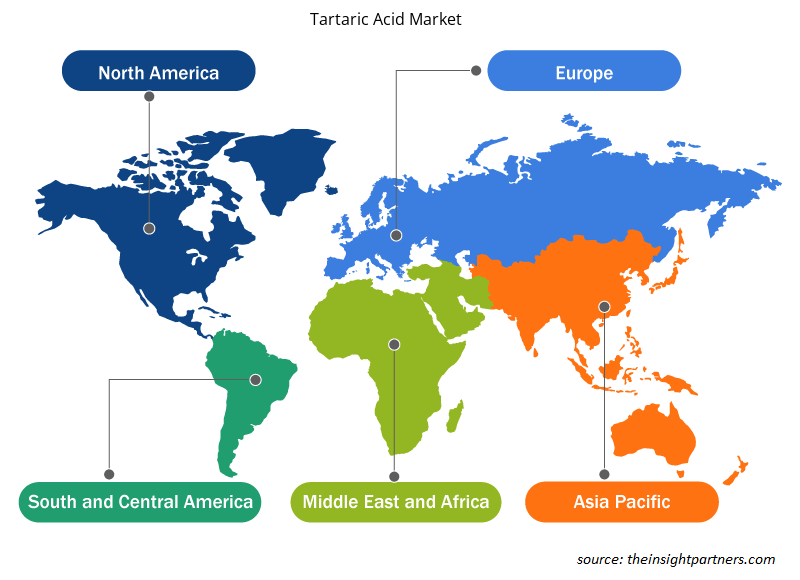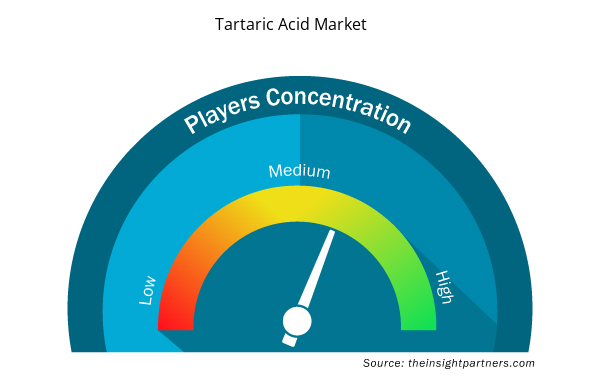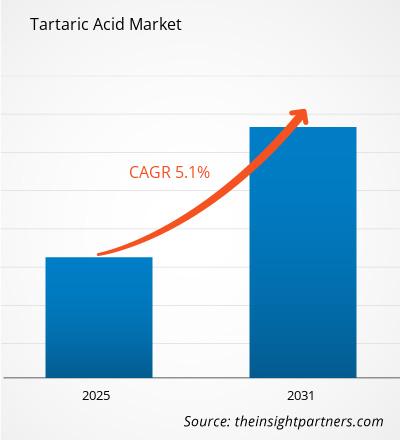Si prevede che il mercato dell'acido tartarico registrerà un CAGR del 5,1% dal 2023 al 2031, con una dimensione di mercato in espansione da XX milioni di dollari USA nel 2023 a XX milioni di dollari USA entro il 2031.
Il report è segmentato per categoria (naturale e sintetica). Il report presenta inoltre un'analisi basata sull'applicazione (cibo e bevande, prodotti farmaceutici, cosmetici e cura della persona e altri). L'ambito del report copre cinque regioni: Nord America, Europa, Asia Pacifico, Medio Oriente e Africa e Sud e Centro America e paesi chiave in ogni regione. L'analisi globale è ulteriormente suddivisa a livello regionale e nei principali paesi. Il report offre il valore in USD per l'analisi e i segmenti di cui sopra.
Scopo del rapporto
Il report Tartaric Acid Market di The Insight Partners mira a descrivere il panorama attuale e la crescita futura, i principali fattori trainanti, le sfide e le opportunità. Ciò fornirà spunti a vari stakeholder aziendali, come:
- Fornitori/produttori di tecnologia: per comprendere le dinamiche di mercato in evoluzione e conoscere le potenziali opportunità di crescita, consentendo loro di prendere decisioni strategiche informate.
- Investitori: condurre un'analisi completa delle tendenze in merito al tasso di crescita del mercato, alle proiezioni finanziarie del mercato e alle opportunità esistenti lungo la catena del valore.
- Enti di regolamentazione: regolamentano le politiche e le attività di controllo sul mercato allo scopo di ridurre al minimo gli abusi, preservare la fiducia degli investitori e sostenere l'integrità e la stabilità del mercato.
Segmentazione del mercato dell'acido tartarico
Categoria
- Naturale e sintetico
Applicazione
- Cibo e bevande
- Prodotti farmaceutici
- Cosmetici e cura della persona
- Altri
Personalizza questo report in base alle tue esigenze
Riceverai la personalizzazione gratuita di qualsiasi report, comprese parti di questo report, o analisi a livello nazionale, pacchetto dati Excel, oltre a usufruire di grandi offerte e sconti per start-up e università
- Scopri le principali tendenze di mercato in questo rapporto.Questo campione GRATUITO includerà analisi di dati che spaziano dalle tendenze di mercato alle stime e alle previsioni.
Fattori di crescita del mercato dell'acido tartarico
- Domanda crescente nei settori alimentare e delle bevande: la domanda crescente di alimenti e bevande aumenta la crescita del mercato dell'acido tartarico. Il suo utilizzo nella produzione di vino come stabilizzante e acidificante e all'interno di prodotti alimentari come lieviti in polvere e cremor tartaro aumenta la sua domanda. L'aumento del consumo di alimenti e bevande trasformati a livello globale aumenta le opportunità di ulteriore crescita di questo prodotto nel mercato mondiale.
- Domanda crescente di integratori e alimenti funzionali a causa dei suoi benefici per la salute: la crescente consapevolezza dei benefici per la salute relativi all'acido tartarico è un fattore importante per la sua espansione di mercato. Contiene proprietà antiossidanti; da allora, il suo utilizzo è in continuo aumento negli integratori alimentari e negli alimenti funzionali. Poiché la consapevolezza della salute dei consumatori sta aumentando insieme alle richieste da quel lato per i benefici nutrizionali dei prodotti, le applicazioni sanitarie altamente richieste alimentano ulteriormente l'attrattiva dell'acido tartarico verso il mercato.
- L'espansione dell'industria farmaceutica alimenta una domanda crescente di acido tartarico: a questo proposito, l'espansione dell'industria farmaceutica ha un impatto positivo sul mercato dell'acido tartarico. L'acido tartarico è un eccipiente utilizzato nelle formulazioni dei farmaci per migliorare la stabilità e l'efficacia dei farmaci. Poiché la domanda nel settore farmaceutico è al suo apice e in continuo aumento in molti mercati in via di sviluppo, aumenta la domanda di acido tartarico nelle applicazioni farmaceutiche e quindi stimola il mercato dell'acido.
Tendenze future del mercato dell'acido tartarico
- Domanda dei consumatori per prodotti naturali e senza additivi: i consumatori sono sempre più interessati a prodotti che sembrano naturali e non contengono additivi artificiali; quindi, i produttori devono sviluppare tali prodotti, partendo da fonti di origine naturali. Ciò non solo avvantaggia il senso estetico, ma sfida anche le aziende a migliorare la qualità e creare formulazioni più sane.
- L'espansione delle applicazioni dell'acido tartarico oltre il cibo apre nuove opportunità di mercato: negli ultimi anni, i produttori hanno aumentato l'uso dell'acido tartarico in numerosi prodotti cosmetici, per la cura della persona e agricoli. Pertanto, l'espansione oltre il cibo e le bevande influisce sulla capacità delle aziende di entrare in nuovi mercati e adattarsi ai mutevoli stili di vita dei consumatori.
- Le tendenze di sostenibilità modellano il mercato dell'acido tartarico e influenzano la fedeltà dei consumatori: una maggiore attenzione alla sostenibilità trasformerà il funzionamento del mercato dell'acido tartarico. Quindi, ci sono più consumatori che richiedono prodotti ecocompatibili con una fonte attraverso mezzi sostenibili. Di conseguenza, i produttori hanno risposto alla domanda e hanno cambiato metodi e politiche per essere ecocompatibili. Ciò non solo darebbe una spinta alla costruzione della reputazione del marchio, ma lavorerebbe anche direttamente con la fonte di valori dei consumatori per la fedeltà e le decisioni di acquisto responsabili in un mercato così competitivo.
Opportunità di mercato dell'acido tartarico
- I mercati emergenti offrono un potenziale di crescita significativo: i mercati emergenti sarebbero opzioni di crescita cruciali per il mercato dell'acido tartarico con redditi in aumento e cambiamenti nella dieta che portano a cibo e bevande. Poiché questi mercati si stanno sviluppando, la domanda di ingredienti per la vinificazione e ingredienti alimentari trasformati come l'acido tartarico aumenta. Sfruttando questo mercato in forte espansione, i produttori possono formulare prodotti adatti ai gusti e alle preferenze locali.
- Diversificazione delle applicazioni in cosmetici, cura della persona e agricoltura: le maggiori opportunità per l'acido tartarico al di fuori di alimenti e bevande possono essere trovate nella diversificazione delle applicazioni. Cosmetici, cura della persona e agricoltura stanno ora iniziando a incorporarlo per le capacità di stabilizzazione e antiossidanti. A questo proposito, i produttori possono espandere i loro portafogli di prodotti, accedendo a maggiori entrate attraverso nuovi mercati e aumentando la loro portata e influenza.
- Espansione dell'e-commerce: l'e-commerce offre opportunità di crescita per il mercato dell'acido tartarico. Mentre i consumatori stanno rendendo sempre più semplice l'acquisto online, i marchi sono in grado di raggiungerli rapidamente tramite piattaforme digitali, consentendo una visibilità maggiore in termini di accesso e vendite per un produttore. Poiché i produttori cercano più vendite dirette al consumatore combinate con una presenza online più forte, possono raggiungere un pubblico più ampio, migliorare le vendite e connettersi con consumatori più sani che cercano qualità.
Approfondimenti regionali sul mercato dell'acido tartarico
Le tendenze regionali e i fattori che influenzano il mercato dell'acido tartarico durante il periodo di previsione sono stati ampiamente spiegati dagli analisti di Insight Partners. Questa sezione discute anche i segmenti e la geografia del mercato dell'acido tartarico in Nord America, Europa, Asia Pacifico, Medio Oriente e Africa e Sud e Centro America.

- Ottieni i dati specifici regionali per il mercato dell'acido tartarico
Ambito del rapporto di mercato dell'acido tartarico
| Attributo del report | Dettagli |
|---|---|
| Dimensioni del mercato nel 2023 | XX milioni di dollari USA |
| Dimensioni del mercato entro il 2031 | XX milioni di dollari USA |
| CAGR globale (2023-2031) | 5,1% |
| Dati storici | 2021-2022 |
| Periodo di previsione | 2024-2031 |
| Segmenti coperti | Per categoria
|
| Regioni e Paesi coperti | America del Nord
|
| Leader di mercato e profili aziendali chiave |
|
Densità degli attori del mercato dell'acido tartarico: comprendere il suo impatto sulle dinamiche aziendali
Il mercato dell'acido tartarico sta crescendo rapidamente, spinto dalla crescente domanda degli utenti finali dovuta a fattori quali l'evoluzione delle preferenze dei consumatori, i progressi tecnologici e una maggiore consapevolezza dei benefici del prodotto. Con l'aumento della domanda, le aziende stanno ampliando le loro offerte, innovando per soddisfare le esigenze dei consumatori e capitalizzando sulle tendenze emergenti, il che alimenta ulteriormente la crescita del mercato.
La densità degli operatori di mercato si riferisce alla distribuzione di aziende o società che operano in un particolare mercato o settore. Indica quanti concorrenti (operatori di mercato) sono presenti in un dato spazio di mercato in relazione alle sue dimensioni o al valore di mercato totale.
Le principali aziende che operano nel mercato dell'acido tartarico sono:
- Gruppo Caviro
- Società di ingegneria biochimica Changmao Limited
- Derivati Vinicoli SA
- Distillerie Bonollo SpA
- Distillerie Mazzari (SPA)
Disclaimer : le aziende elencate sopra non sono classificate secondo un ordine particolare.

- Ottieni una panoramica dei principali attori del mercato dell'acido tartarico
Punti di forza chiave
- Copertura completa: il rapporto copre in modo completo l'analisi di prodotti, servizi, tipologie e utenti finali del mercato dell'acido tartarico, fornendo una panoramica olistica.
- Analisi degli esperti: il rapporto è compilato sulla base della conoscenza approfondita di esperti e analisti del settore.
- Informazioni aggiornate: il rapporto garantisce la pertinenza aziendale grazie alla copertura di informazioni recenti e tendenze nei dati.
- Opzioni di personalizzazione: questo report può essere personalizzato per soddisfare le esigenze specifiche del cliente e adattarsi in modo appropriato alle strategie aziendali.
Il rapporto di ricerca sul mercato dell'acido tartarico può, quindi, aiutare a guidare il percorso di decodificazione e comprensione dello scenario del settore e delle prospettive di crescita. Sebbene possano esserci alcune preoccupazioni valide, i vantaggi complessivi di questo rapporto tendono a superare gli svantaggi.
- Analisi storica (2 anni), anno base, previsione (7 anni) con CAGR
- Analisi PEST e SWOT
- Valore/volume delle dimensioni del mercato - Globale, regionale, nazionale
- Industria e panorama competitivo
- Set di dati Excel



Report Coverage
Revenue forecast, Company Analysis, Industry landscape, Growth factors, and Trends

Segment Covered
This text is related
to segments covered.

Regional Scope
North America, Europe, Asia Pacific, Middle East & Africa, South & Central America

Country Scope
This text is related
to country scope.
Domande frequenti
Consumers prefer natural ingredients, prompting a focus on tartaric acid from natural sources is expected to be the key market trend
The report can be delivered in PDF/Word format, we can also share excel data sheet based on request.
On the basis of geography, the tartaric acid market is classified into North America, Europe, Asia Pacific, Middle East and Africa, and South and Central America
The Tartaric Acid Market is estimated to witness a CAGR of 5.1% from 2023 to 2031
The major factors driving the tartaric acid market are:
1. Rising demand for tartaric acid in winemaking and food production fuels market growth.
2. Recognition of tartaric acid's antioxidant properties boosts its use in dietary supplements.
ATPGroup, Anhui Hailan Bio-technology Co ltd, Changmao Biochemical Engineering Co Ltd, Dastech International Inc, Distillerie Mazzari SpA, Giovanni Randi SpA, Industria Chimica Valenzana ICV SpA, Tártaros Gonzalo Castelló, Vinicas
Trends and growth analysis reports related to Food and Beverages : READ MORE..
1.Caviro Group
2.Changmao Biochemical Engineering Company Limited
3.Derivados Vínicos SA
4.Distillerie Bonollo S.p.A
5.Distillerie Mazzari (S.P.A.)
6.Merck KGaA
7.Omkar Speciality Chemicals Limited
8.PAHI, S.L.
9.Tarac Technologies Pty Ltd
10.The ATP Group
The Insight Partners performs research in 4 major stages: Data Collection & Secondary Research, Primary Research, Data Analysis and Data Triangulation & Final Review.
- Data Collection and Secondary Research:
As a market research and consulting firm operating from a decade, we have published and advised several client across the globe. First step for any study will start with an assessment of currently available data and insights from existing reports. Further, historical and current market information is collected from Investor Presentations, Annual Reports, SEC Filings, etc., and other information related to company’s performance and market positioning are gathered from Paid Databases (Factiva, Hoovers, and Reuters) and various other publications available in public domain.
Several associations trade associates, technical forums, institutes, societies and organization are accessed to gain technical as well as market related insights through their publications such as research papers, blogs and press releases related to the studies are referred to get cues about the market. Further, white papers, journals, magazines, and other news articles published in last 3 years are scrutinized and analyzed to understand the current market trends.
- Primary Research:
The primarily interview analysis comprise of data obtained from industry participants interview and answers to survey questions gathered by in-house primary team.
For primary research, interviews are conducted with industry experts/CEOs/Marketing Managers/VPs/Subject Matter Experts from both demand and supply side to get a 360-degree view of the market. The primary team conducts several interviews based on the complexity of the markets to understand the various market trends and dynamics which makes research more credible and precise.
A typical research interview fulfils the following functions:
- Provides first-hand information on the market size, market trends, growth trends, competitive landscape, and outlook
- Validates and strengthens in-house secondary research findings
- Develops the analysis team’s expertise and market understanding
Primary research involves email interactions and telephone interviews for each market, category, segment, and sub-segment across geographies. The participants who typically take part in such a process include, but are not limited to:
- Industry participants: VPs, business development managers, market intelligence managers and national sales managers
- Outside experts: Valuation experts, research analysts and key opinion leaders specializing in the electronics and semiconductor industry.
Below is the breakup of our primary respondents by company, designation, and region:

Once we receive the confirmation from primary research sources or primary respondents, we finalize the base year market estimation and forecast the data as per the macroeconomic and microeconomic factors assessed during data collection.
- Data Analysis:
Once data is validated through both secondary as well as primary respondents, we finalize the market estimations by hypothesis formulation and factor analysis at regional and country level.
- Macro-Economic Factor Analysis:
We analyse macroeconomic indicators such the gross domestic product (GDP), increase in the demand for goods and services across industries, technological advancement, regional economic growth, governmental policies, the influence of COVID-19, PEST analysis, and other aspects. This analysis aids in setting benchmarks for various nations/regions and approximating market splits. Additionally, the general trend of the aforementioned components aid in determining the market's development possibilities.
- Country Level Data:
Various factors that are especially aligned to the country are taken into account to determine the market size for a certain area and country, including the presence of vendors, such as headquarters and offices, the country's GDP, demand patterns, and industry growth. To comprehend the market dynamics for the nation, a number of growth variables, inhibitors, application areas, and current market trends are researched. The aforementioned elements aid in determining the country's overall market's growth potential.
- Company Profile:
The “Table of Contents” is formulated by listing and analyzing more than 25 - 30 companies operating in the market ecosystem across geographies. However, we profile only 10 companies as a standard practice in our syndicate reports. These 10 companies comprise leading, emerging, and regional players. Nonetheless, our analysis is not restricted to the 10 listed companies, we also analyze other companies present in the market to develop a holistic view and understand the prevailing trends. The “Company Profiles” section in the report covers key facts, business description, products & services, financial information, SWOT analysis, and key developments. The financial information presented is extracted from the annual reports and official documents of the publicly listed companies. Upon collecting the information for the sections of respective companies, we verify them via various primary sources and then compile the data in respective company profiles. The company level information helps us in deriving the base number as well as in forecasting the market size.
- Developing Base Number:
Aggregation of sales statistics (2020-2022) and macro-economic factor, and other secondary and primary research insights are utilized to arrive at base number and related market shares for 2022. The data gaps are identified in this step and relevant market data is analyzed, collected from paid primary interviews or databases. On finalizing the base year market size, forecasts are developed on the basis of macro-economic, industry and market growth factors and company level analysis.
- Data Triangulation and Final Review:
The market findings and base year market size calculations are validated from supply as well as demand side. Demand side validations are based on macro-economic factor analysis and benchmarks for respective regions and countries. In case of supply side validations, revenues of major companies are estimated (in case not available) based on industry benchmark, approximate number of employees, product portfolio, and primary interviews revenues are gathered. Further revenue from target product/service segment is assessed to avoid overshooting of market statistics. In case of heavy deviations between supply and demand side values, all thes steps are repeated to achieve synchronization.
We follow an iterative model, wherein we share our research findings with Subject Matter Experts (SME’s) and Key Opinion Leaders (KOLs) until consensus view of the market is not formulated – this model negates any drastic deviation in the opinions of experts. Only validated and universally acceptable research findings are quoted in our reports.
We have important check points that we use to validate our research findings – which we call – data triangulation, where we validate the information, we generate from secondary sources with primary interviews and then we re-validate with our internal data bases and Subject matter experts. This comprehensive model enables us to deliver high quality, reliable data in shortest possible time.


 Ottieni un campione gratuito per questo repot
Ottieni un campione gratuito per questo repot